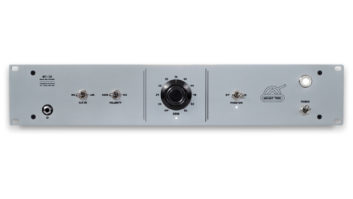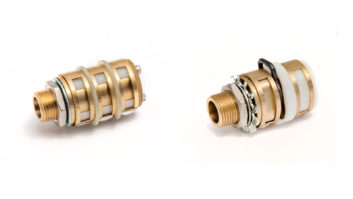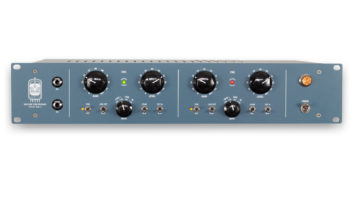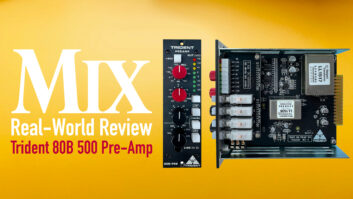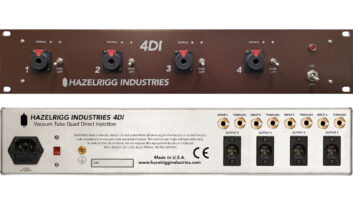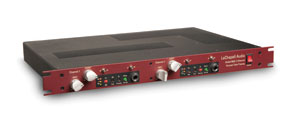
LaChapell Audio is a Nashville-based company comprising designer Scott LaChapell and his father, a retired senior design engineer at Lawrence Livermore Labs who brings the electronics expertise. The 983S reviewed here is their fifth product and is based on the company’s 583, a 500 Series preamp module. LaChapell takes a no-compromise approach to design, fit and finish, and it shows in the 983S, which I was able to use across a range of sessions and inputs.
Each channel of the 983S uses a Jensen JT-115 input transformer and a 12AX7/ECC83 vacuum tube. The instrument stage feeds the Hi-Z input directly to the tube and is transformerless. At the output is a Burr-Brown and THAT line driver feeding a Jensen JT-11 output transformer with an 80-percent nickel allow core. The manual is simple and well written, offering some great ideas for using the device, plus provides a whole complement of suggestions for changing the tube to customize the 983S to your own taste. (It offers ECC803, E83CC, CV4004, 6057, M8137, C492, 7025 and 5751 as user-swappable variations even offering to honor the warranty as long as you color within the lines, so to speak.)
The front panel is well–laid out and offers the usual things you’d expect on a preamp, with a few extras. Controls include separate input and output gain, polarity flip, -20dB pad, phantom power and a ¼-inch instrument input. There are also switchable 50Hz and 150Hz highpass filters, 5kHz and 10kHz lowpass filters, three LED confidence meters (green input, orange and red output), and one of my favorite things on any preamp: a mute switch. This is especially useful in a desktop-based studio where you don’t have the benefit of quickly accessible console channel mutes to or from the recorder. The front toggles are transparent and LED-backlit, giving a clear indication of the status even from a distance or across a brightly lit room.
Into the Studio
I used the 983S in Studio I at The Blackbird Academy on multiple tracking and overdub sessions. The room is built around 32 channels of Dangerous Music’s 2-Bus summing system, a Monitor ST, the latest converters from Avid (Pro Tools HDX), and a bevy of outboard gear for the front and back end. Everything from the tech power at the outlet to the listener’s ear is top of the game, and either patched or relay-switched. This makes it easy to hear what’s going on with microphones, preamps and outboard gear without wondering if the connective tissue is adding to the mix.
I first used the 983S to power a pair of AKG C 12 microphones over a drum kit. I often stay away from tube-to-tube signal flow when picking mics and preamps, but I had high expectations for the 983S and I wasn’t disappointed. I first set the output gain higher than the input, wanting to drive the tubes less for a cleaner sound, much like a guitar amp. The cymbals were clear and the rest of the Craviotto maple kit was punchy with plenty of great mids and bottom end. On one session I patched the NTI Nightpro NT3 EQ into the chain to add some top and low end, and on another, the Dangerous BAX EQ. Both provided excellent clear air at the top and beefed up the kick and toms at the bottom end. This let me build most of my mix from the overheads adding the local mics for stereo placement and extra presence.
On another session, I used the 983S to power a Schoeps V4U microphone used to record a lead vocal. The mic has a clear and open top end, almost too open for my taste, and sometimes pairing a super clean mic like the V4U through a pristine preamp like a GML or Millennia HV-3 can be too much of a good thing. It may work for jazz or orchestral detail, but when you want some personality to provide some glue to set something in a track, a tube is just what’s needed. In this case, for this male vocalist, the 983S tamed the clean edge of the mic just enough to give the vocal the right personality for the track.
I used the same Schoeps V4U and a Royer 121 as a pair, placed high in an iso booth when recording a fiddle. Later, the same player switched to banjo, so I pulled the same two mics down closer to the instrument. Both fiddle and banjo can be tricky because they can be strident when closely miked. The combination of the ribbon mic and the tube preamp gave me a number of gain vs. mic combinations to play with. The ultimate mix was 80-percent Royer, with the input gain hotter than the output on the 983S, and 20-percent of the V4U, with the preamp set to a more clean gain setting. The V4U added the right touch of higher, cleaner frequencies to bring out these instruments in the mix without EQ.
The manual offers a tip for getting more tube flavor out of the 983S that I tried on a few guitar amp recordings. I used the 983S to power an RCA BK-5A and Sennheiser 421 placed on a Marshall cabinet and JCM800 head combination. As I mentioned, the combination of input and output gain settings gives you control over the distortion; however, if you add the pad and then gas the input to make up your gain, you’ll get even more tube-y flavor. This was exactly the case for this guitar setup. Even though the BK-5A didn’t need a pad, being a ribbon with low output, I flipped the pad on, then gained up the input and brought down the output. This setting gave me even more control over the distortion in the control room on the way to Pro Tools.
On the Bench
We put the 983S on the bench using a Stanford Research SR1 analyzer, which gave some perspective on what makes it tick. For full details, download the Bench Test PDF document posted on mixonline.com. With gain set optimally for the cleanest possible path through the unit (Input 10 o’clock – output 12 o’clock), the generator set at -30 dBu @ 1kHz, the THD+N is 0.301% for the left channel and 0.269% for the right. If this were a preamp from Millennia or Grace, this would be alarming, but the 983S is a tube preamp and supports the high distortion figures. It’s interesting that most of the distortion is produced in the 2k range (-50.44 dB), while the upper-frequency distortion products are generally inaudible in the -100dB range. This works great with big guitar sounds, which benefit from some hair around 2k. There were some differences in the left vs. right figures in the bench test, but it wasn’t anything I noticed when using the preamps as a pair. With a preamp of this type, these kinds of differences fall into the “personality” department. (Please download the Bench Test report from mixonline; it’s worth a look-see.)
In the End
The 983S is an excellent mic preamp. The controls are well thought out and I found it to be a wonderful creative tool in the studio. The only downside I can see is the price. At $1,125 per channel (street), it is clearly in the boutique category. However, if you’re looking for a tube preamp with plenty of gain, rock-solid design and legs to go the distance, this is the one. The 983S sounds great, has much leeway for gain vs. distortion play, and is an instant classic.
Kevin Becka is Mix magazine’s technical editor.
Product Summary
COMPANY: LaChapell Audio
PRODUCT: 983S Preamp
WEBSITE:lachapellaudio.com
PRICE: $2,400
PROS: Well-designed and implemented. Great sound.
CONS: Price is out of reach for some.
Try This
Set the input gain at 10 o’clock and output gain at 12 o’clock when first setting up the 983S. This is the setup most likely to give you a cleaner sound. Then, if the track needs it, turn up the input and gain down the output to maintain nominal level to the recorder while adding more distortion to the signal.
